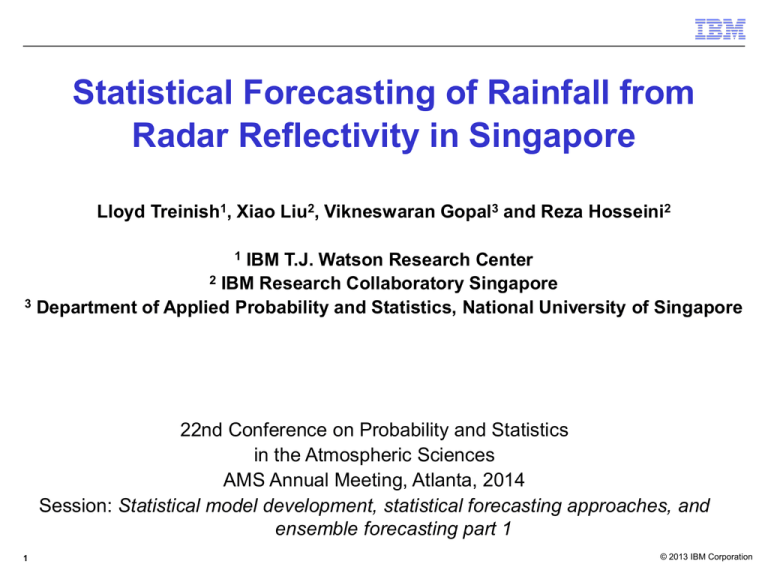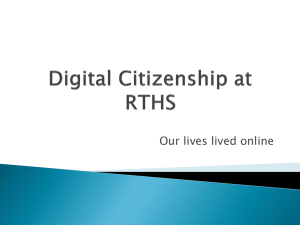Statistical forecasting of rainfall from radar reflectivity in Singapore
advertisement

Statistical Forecasting of Rainfall from Radar Reflectivity in Singapore Lloyd Treinish1, Xiao Liu2, Vikneswaran Gopal3 and Reza Hosseini2 1 IBM T.J. Watson Research Center 2 IBM Research Collaboratory Singapore 3 Department of Applied Probability and Statistics, National University of Singapore 22nd Conference on Probability and Statistics in the Atmospheric Sciences AMS Annual Meeting, Atlanta, 2014 Session: Statistical model development, statistical forecasting approaches, and ensemble forecasting part 1 1 © 2013 IBM Corporation Agenda Introduction – Background and Objectives – Data Marshall-Palmer relationship Recalibration of the Z-R relationship using least squares Recalibration of the Z-R relationship using quantile regression Optimization of the Z-R relationship for Singapore Conclusions 2 © 2013 IBM Corporation Background A joint development between IBM Research and the National Environmental Agency (NEA), Singapore Objectives: 1. Recalibrate the Z-R relationship for Singapore 2. Compare different methods that convert radar reflectivity factor (Z) to rainfall intensity (R) 3. Optimize model parameters of the Z-R relationship for Singapore 3 Our research is still on-going, and preliminary findings are presented © 2013 IBM Corporation About Singapore Singapore is located at the southern tip of the Malay Peninsula and is 137 kilometres (85 mi) north of the equator. Average annual rainfall ~ 2,342mm (92 inches) – Rio de Janeiro ~46 inches – New York: ~50 inches (total precipitation) – Seattle: ~38 inches (total precipitation) Singapore The “Four Seasons” in Singapore – North-East Monsoon Season (Dec to Mar) – Inter-Monsoon Season (Apr and May) – South-West Monsoon Season (Jun and Sep) – Inter-Monsoon Season (Oct and Nov) This study focuses on the relationship between reflectivity factor and rainfall rate (i.e., the Z-R relationship) for Singapore during the two intermonsoon seasons 4 © 2013 IBM Corporation Data Weather radar reflectivity data: – 30 heavy rain events in 2010 and 46 heavy rain events in 2011 – Cartesian grid of 480 by 480 pixels – Top left corner: E102.892, N2.42799 – Lower right: E105.052, N0.269748 – Spatial resolution: 0.5 by 0.5 kilometres – Sampling frequency: 5min dBZ Illustration: (E102.892, N2.42799) Singapore 5 (E105.052, N0.269748) © 2013 IBM Corporation Example: A typical inter-monsoon season convective storm See animation in full-screen model 6 Key features: Developed quickly (hard to predict that it’s coming) Lifetime: within 1 to 3 hours Heavy rainfall © 2013 IBM Corporation Data Raingauge Data: – Number of stations: 64 – Sampling frequency: 5min Illustration: 7 © 2013 IBM Corporation Data dBZ-dBG pairs – 46 inter-monsoon heavy rains in 2011 – 88274 pairs – 70008 pairs with zero rainfall dBG is based on hourly rainfall intensity in mm/h 8 © 2013 IBM Corporation Marshall-Palmer Relationship MP relationship (Marshall-Palmer, 1948) Z = aR b where a = 200, b = 1.6 R : rainfall intensity, mm/h; Fitting result: 9 Z : reflectivity factor, mm- 6 m3 Marshall-Palmer © 2013 IBM Corporation Performance Assessment of the MP Relationship Marshall-Palmer (tested on 2010 data) POD (20mm/h ~ 30mm/h) 32% FAR (20mm/h ~ 30mm/h) 69% POD (30mm/h ~ 50mm/h) 34% FAR (30mm/h ~ 50mm/h) 53% POD (50mm/h ~ 70mm/h) 9% FAR (50mm/h ~ 70mm/h) 66% POD: Probability of Detection 10 FAR: False Alarm Rate © 2013 IBM Corporation Least Squares Recalibrate the Z-R relationship for Singapore Method 1: Least squares (LS) – Advantages: simple and commonly used – Disadvantages: the normality assumption of residuals is violated; sensitive to outliers. Fitting Results: Z = 214R1.28 MP LS 11 © 2013 IBM Corporation Performance Assessment and Comparison Least Squares Marshall-Palmer (tested on 2010 data) (fitted using 2011 data; tested on 2010 data) POD (20mm/h ~ 30mm/h) 32% 20% FAR (20mm/h ~ 30mm/h) 69% 89% POD (30mm/h ~ 50mm/h) 34% 26% FAR (30mm/h ~ 50mm/h) 53% 90% POD (50mm/h ~ 70mm/h) 9% 20% FAR (50mm/h ~ 70mm/h) 66% 95% Although the LS method minimizes the sum of squared error, it is apparently NOT a good choice if the goal is to estimate the rainfall intensity from reflectivity. 12 © 2013 IBM Corporation Quantile Regression Recalibrate the Z-R relationship for Singapore Method 2: Quantile Regression (QR) – Advantages: Robust against outliers; Outperforms least squares when the normality assumption is violated Fitting Results: Z = 211R1.38 MP QR LS 13 © 2013 IBM Corporation Performance Assessment and Comparison MarshallPalmer Least Squares Quantile Regression (tested on 2010 data) (fitted using 2011 data; tested on 2010 data) (fitted using 2011 data; tested on 2010 data) POD (20mm/h ~ 30mm/h) 32% 20% 28% FAR (20mm/h ~ 30mm/h) 69% 89% 79% POD (30mm/h ~ 50mm/h) 34% 26% 41% FAR (30mm/h ~ 50mm/h) 53% 90% 75% POD (50mm/h ~ 70mm/h) 9% 20% 48% FAR (50mm/h ~ 70mm/h) 66% 95% 85% In terms of POD, the Quantile Regression outperforms the other two for heavy rainfall prediction, especially when the intensity is larger than 50mm/h In terms of FAR, the Quantile Regression is not as good as the default MP relationship. In general, considering the significant improvement of POD by the quantile regression, we still think the quantile regression outperforms despite the relatively larger FAR. 14 © 2013 IBM Corporation Optimize Model Parameters Both POD and FAR are determined by the values of a and b Why not to find the optimum values of a and b that maximize POD subject to the maximum FAR constraint? In this study, we are particularly interested in predicting extremely heavy rainfall events with intensity within 50~70 mm/h. This leads to the following optimization problem. POD for rainfall intensity within 50~70mm/h (to be maximized) max POD(a, b) s.t. FAR(a, b) £ 0.66 FAR of MP relationship for rainfall intensity within 50~70mm/h We are searching for a and b that 1) maximize the POD for rainfall intensity within 50~70mm/h, and 2) with FAR not greater than that of the default MP relationship 15 © 2013 IBM Corporation Optimize Model Parameters Recalibrate the Z-R relationship for Singapore Method 3: Maximization of POD for Rainfall Intensity within 50-70mm/h Results: Z = 45R1.9 MP QR LS Optimized to maximize POD 16 © 2013 IBM Corporation Performance Assessment and Comparison Marshall-Palmer (tested on 2010 data) Least Squares (fitted using 2011 data; tested on 2010 data) Quantile Regression (fitted using 2011 data; tested on 2010 data) With Optimized a and b (fitted using 2011 data; tested on 2010 data) POD (20~30mm/h) 32% 20% 28% 44% FAR (20~30mm/h) 69% 89% 79% 70% POD (30~50mm/h) 34% 26% 41% 55% FAR (30~50mm/h) 53% 90% 75% 59% POD (50~70mm/h) 9% 20% 48% 25% FAR (50~70mm/h) 66% 95% 85% 59% Conclusions: 1. The Z-R relationship in Singapore can be significantly improved over the default Marshall-Palmer relationship; 2. When the goal is to predict the rainfall intensity from reflectivity, the optimum values of a and b are those that maximize the POD subject to the maximum FAR constraint; 3. It is interesting to see that a good fitting of the dBZ-dBG pairs (such as least squares or quantile regression) does not necessarily imply high accuracy in rainfall prediction based on reflectivity. 17 © 2013 IBM Corporation






